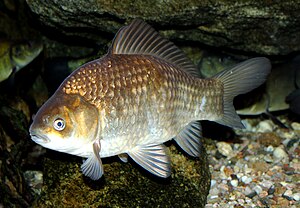Carp fish-like
| Carp fish-like | ||||||||||||
|---|---|---|---|---|---|---|---|---|---|---|---|---|

Crucian carp ( Carassius carassius ) |
||||||||||||
| Systematics | ||||||||||||
|
||||||||||||
| Scientific name | ||||||||||||
| Cyprinoidei | ||||||||||||
The carp fish-like (Cyprinoidei) or carp fish relatives are a subordination of the carp-like (Cypriniformes). Carp-like fish are primary freshwater fish and were originally only found in Europe, Asia, Africa and North America, so were absent in Central and South America as well as in Australia, New Zealand , east of the Wallace Line and all oceanic islands. The carp fish-like species include over 220 species of fish and over 2700 species (Nelson (2006)).
features
Diagnostic features of the carp fish-like are the toothless jaws, the sickle-shaped lower pharyngealia ( pharyngeal bones ) and the lack of an adipose fin .
Systematics
The superfamily of the carp-fish-like forms together with the loach-like the order of the carp-like , which thus includes the majority of all freshwater fish. Traditionally, the carp fish-like are divided into two families:
- the carp fish (Cyprinidae) with over 2700 species and
- the spindle loaches (Psilorhynchidae) with 18 species.
In 2016, the previous subfamilies of the carp fish (Cyprinidae) were raised to the rank of independent families by Stout and colleagues.

- Suborder carp fish-like (Cyprinoidei)
- Spindle loaches (Psilorhynchidae) (over 20 species)
- Paedocyprididae (3 species)
- Carp fish (Cyprinidae)
- Sundadanionidae ( Sundadanio and Fangfangia , 9 species)
- Bärblinge (Danionidae) (over 300 species)
- Leptobarbidae (5 species)
- Xenocyprididae
- Tench (Tincidae) (1 species)
- Bitterlings (Acheilognathidae) (about 75 species)
- Gudgeon relatives (Gobionidae) (about 200 species)
- Cardinal fish (Tanichthyidae) (3 species)
- White fish (Leuciscidae) (over 350 species)
The family relationships are illustrated by the following cladogram:
| Cypriniformes |
|
||||||||||||||||||||||||||||||||||||||||||||||||||||||||||||||||||
|
|
literature
- Joseph S. Nelson : Fishes of the World , John Wiley & Sons, 2006, ISBN 0-471-25031-7
Individual evidence
- ↑ a b Stout, CC, Tan, M., Lemmon, AR, Moriarty Lemmon, E. & Armbruster, JW (2016): Resolving Cypriniformes relationships using an anchored enrichment approach. BMC Evolutionary Biology, November 2016. DOI: 10.1186 / s12862-016-0819-5